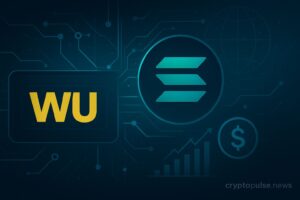Trump-Linked Stablecoin Powers $2B Binance Investment
USD1, a stablecoin launched by Trump-affiliated World Liberty Financial, facilitates a major $2 billion crypto investment from Abu Dhabi into Binance.
In a development that underscores the growing fusion of political influence and crypto finance, USD1, a dollar-backed stablecoin created by World Liberty Financial—a firm linked to U.S. President Donald Trump—has been selected to facilitate a massive $2 billion investment in Binance by an Abu Dhabi-based firm. The move positions USD1 as a fast-rising player in the stablecoin market, with deep geopolitical and regulatory implications.
USD1 Gains Traction with Major Binance Deal
The announcement was made at a crypto conference in Dubai, where Zach Witkoff, co-founder of World Liberty Financial (WLFI) and son of Trump’s former envoy Steve Witkoff, revealed that USD1 had been chosen by MGX, an investment firm in Abu Dhabi, to close its multibillion-dollar deal with Binance.
“We are excited to announce today that USD1 has been selected as the official stablecoin to close MGX’s $2 billion investment in Binance,” Witkoff said during the conference.
The selection of USD1 for such a high-profile transaction adds momentum to WLFI’s ambition to challenge traditional banking intermediaries by leveraging blockchain technology for financial democratization. The stablecoin, pegged 1:1 to the U.S. dollar and reportedly backed by U.S. Treasuries, cash, and other equivalents, has seen its circulation rapidly swell—reaching $2.1 billion in just months, according to recent data.
Shadowy Wallet Activity Raises Eyebrows
Fueling the intrigue surrounding USD1’s ascent is the emergence of a mysterious wallet that received nearly $2 billion worth of USD1 between April 16 and April 29. While the wallet’s identity has not been disclosed, the timeline aligns closely with the finalization of the MGX-Binance investment, suggesting a likely connection.
This lack of transparency regarding major holders has drawn scrutiny from analysts, particularly given WLFI’s political affiliations and the volatile regulatory landscape surrounding crypto-assets.
CZ Meets WLFI Founders in Abu Dhabi
Adding a layer of visibility to the partnership, Changpeng “CZ” Zhao, Binance’s founder and former CEO, was recently photographed in Abu Dhabi alongside Witkoff and other WLFI executives. The image was shared on social media, with Zhao posting, “It was great to see our friends,” in a caption that tagged Witkoff and subtly endorsed the burgeoning alliance.
Zhao, who stepped down from Binance’s leadership in 2023 as part of a $4.3 billion settlement with U.S. authorities over anti-money laundering violations, retains a significant ownership stake in the exchange. He also recently served a four-month prison term, further complicating Binance’s efforts to rebuild trust among global regulators.
Despite these challenges, Binance remains the world’s largest crypto exchange by trading volume, and the $2 billion infusion represents a crucial strategic investment amid ongoing compliance reforms and market expansion efforts.
Strategic Blockchain Moves and Influential Backers
USD1’s footprint is expected to grow further with an upcoming integration into the Tron blockchain, a platform developed by Justin Sun, the controversial Hong Kong-based crypto entrepreneur and WLFI’s largest investor.
Sun, who has invested at least $75 million into World Liberty Financial, continues to face legal headwinds, including a U.S. securities fraud lawsuit that was recently paused by the SEC due to “public interest considerations.” His alignment with WLFI adds another layer of complexity to the stablecoin’s profile, especially as regulatory scrutiny of both stablecoins and centralized exchanges intensifies.
At the Dubai conference, Sun also moderated a panel featuring Zach Witkoff and Eric Trump, further spotlighting the Trump family’s close ties to the venture. This high-level exposure has fueled debate around the blending of political influence, crypto business, and global capital flows.
Trump’s Crypto Playbook: Reform and Revenue
President Donald Trump has increasingly styled himself as a “pro-crypto president”, pledging to overhaul U.S. regulations around digital assets. However, critics argue that his business entanglements—particularly through family-connected ventures like WLFI—may raise potential conflicts of interest.
While Trump’s campaign maintains that he no longer manages his business affairs directly, instead delegating control to his children, watchdog groups have called for more transparency, especially as WLFI’s global activities grow more ambitious.
Trump’s deepening involvement in the crypto space coincides with rising Republican support for digital assets and opposition to what many conservatives see as overreach by regulatory bodies like the SEC and the Federal Reserve.
Stablecoin Market Faces New Contender
USD1’s emergence adds a new dynamic to the increasingly competitive stablecoin sector, currently dominated by Tether (USDT) and Circle’s USDC. Its rapid climb to $2.1 billion in circulation, driven by one of the year’s largest capital movements, places it firmly in the spotlight.
Key differentiators for USD1 include:
- Full dollar peg backed by government securities and cash reserves.
- Cross-chain deployment plans, starting with Tron integration.
- Strategic support from Middle Eastern capital and U.S. political figures.
- Potential exposure to regulatory and reputational risks due to its associations.
Whether USD1 can maintain its momentum in a market increasingly demanding transparency and compliance remains to be seen.
Read more: What Are Stablecoins and Their Role in Modern Finance
Conclusion: Power, Politics, and the Future of Crypto Finance
The use of USD1 in a high-stakes $2 billion transaction with Binance marks a defining moment not only for World Liberty Financial but for the evolving relationship between crypto, geopolitics, and institutional investment. Backed by political elites, buoyed by Middle Eastern capital, and steered by crypto veterans navigating legal challenges, USD1 symbolizes both the promise and the perils of blockchain finance in 2025.
As regulatory scrutiny intensifies and public interest in financial accountability grows, the future of such politically entangled ventures will depend on their ability to deliver on promises of stability, transparency, and real-world utility—without compromising the decentralized ethos that gave rise to the crypto revolution in the first place.








